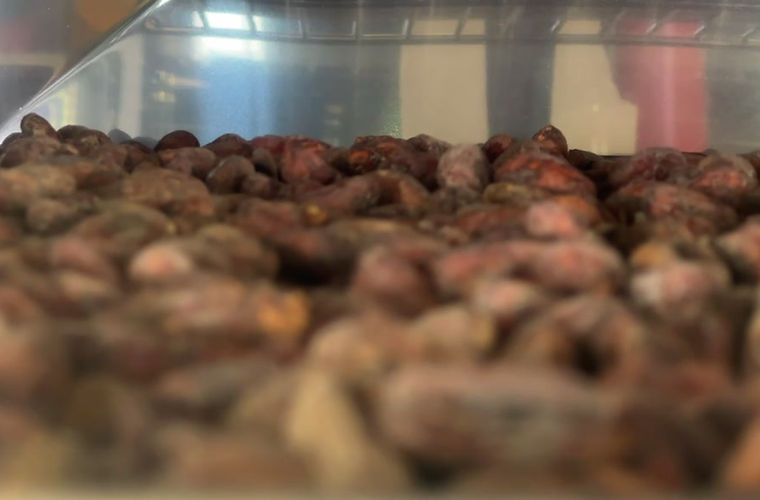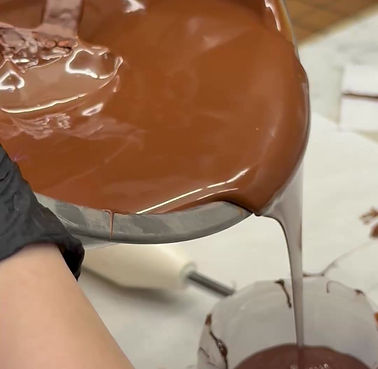From Bean to Bar
Our chocolate begins at the source. We craft every batch from scratch, blending 60% Madagascar and 40% Ecuador cacao to highlight the best of both origins—bright, fruity acidity from Madagascar and deep, earthy richness from Ecuador. It’s a careful balance, made with intention, transparency, and respect for the bean.


THE BEANS.
Our chocolate is hand-selected from Cacao beans from Madagascar (60%) and Ecuador (40%). Each varietal is specially selected for their own unique tastes and flavor profiles in order to create a vibrant and fruit forward bar of our own creation.
HARVESTING

Ripe cocoa pods are harvested from the tree using knives or machetes, and then split open to extract the beans and their surrounding pulp.
FERMENTING

Freshly harvested cocoa beans, still coated in pulp, are left to ferment in boxes or heaps, often covered with leaves, allowing natural yeasts and bacteria to convert the pulp's sugars into acids and alcohols.
DRYING

Drying is a crucial step after fermentation, essential for halting microbial activity and preventing mold growth in the beans

ROASTING
The roasting process is a critical step in bean bar chocolate making. The raw beans are heated to develop their full flavor potential. The heat transforms the chemical composition of the beans, reducing their bitterness and enhancing the rich, complex flavors of chocolate. Roasting also helps to sterilize the beans and makes it easier to remove them from their shells for the winnowing process. The time and temperature control are crucial during roasting to achieve the perfect balance of flavors, essential for high-quality chocolate.
CRACKING
After the cacao beans have been selected and roasted, they need to be cracked to separate the cocoa nibs from the harder outer shell -or the cacao husk. This step involves crushing the cacao bean into smaller pieces to expose the inner nibs while detaching the outer shell, which is inedible and only adds unnecessary bulk to the finished chocolate.
Cracking of the cacao beans can be done manually or with a Cocoa Cracker Machine.
Traditionally, the beans would be cracked with mortar and pestle; in our case a wooden dowel rod was used to crack the beans.

WINNOWING



After cracking the beans, we start on the winnowing. It is the process of separating the roasted cacao bean husks from the inner nibs. Specialized equipment cracks the beans and uses airflow to remove the husks, leaving behind the nibs, which are essential for chocolate production. Proper winnowing ensures a smooth texture and refined flavor in the final chocolate product.
MELANGING
In our bean-to-bar chocolate making process, melanging is a critical step that follows winnowing. Melanging involves grinding the cocoa nibs into a fine paste using a melanger. It has two stone rollers that rotate on a stone base. During the melanging process, the nibs are crushed and ground for up to 72, to achieve a smooth, fine texture. This extended grinding refines the particle size of the cocoa solids and sugar (if added) and helps in the development of flavors as the heat generated during grinding promotes the melding of flavors. Conching often occurs simultaneously or as a subsequent step, further aerates the chocolate, removing volatile acids and improving the overall mouthfeel and flavor profile of the final product.
GRINDING/CONCHING
Once we had clean nibs, we started grinding. We first broke the nibs down in a food processor until they formed a coarse paste. This paste was then transferred to a grinder, which is called a Melanger. To keep the machine running smoothly, we alternated between adding melted cocoa butter and sugar. The mixture was left to grind continuously for 72 hours, which helped reduce particle size, develop a smooth texture, and allow unwanted volatile compounds to escape. We checked particle size using a grindometer until the chocolate reached the desired fineness.



Tempering
Tempering in our bean-to-bar chocolate making is the process of heating, cooling, and reheating the chocolate to stabilize cocoa butter crystals. This process ensures the final product has a smooth texture, shiny appearance, and a satisfying snap, preventing issues like blooming and ensuring the chocolate sets correctly and maintains its quality.

MOLDING
After tempering, we deposited 75 grams of the chocolate into bar molds that we had pre-decorated with gold leaf. We gently tapped the molds on the table to remove any air bubbles and ensure even distribution. The molds were then chilled in the refrigerator for roughly 20 minutes. Once set, we left the bars in the molds and carefully packaged them to protect the surface until our wrapping materials were ready.



PACKAGING
Every box of Cocoa Theory chocolates is wrapped with the same care and attention we give to what’s inside. Our packaging is designed to protect delicate pieces while highlighting their beauty as a thoughtful, minimal, and gift-ready package. It’s the final touch in sharing something truly special.
Address
70 Ganache Grove, Truffle CA 90210
Phone
707.867.5309
@cia.culinary.edu